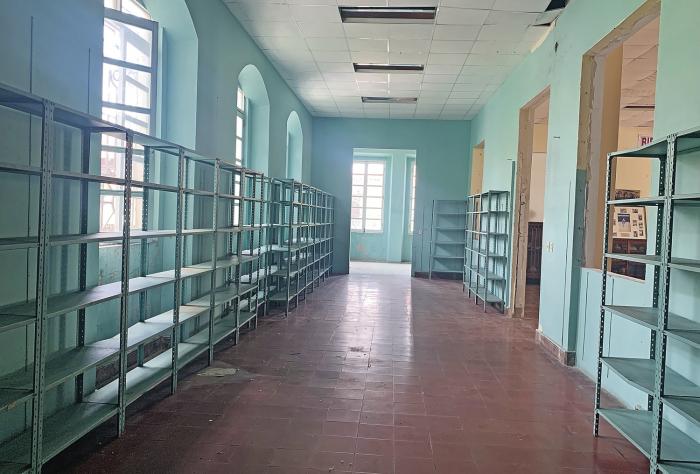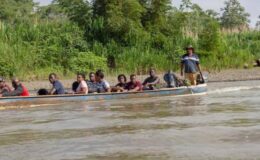The mystery of how 9000 books ended up in a landfill. A real “whodunnit?”
- By : James Bryson
- Category : Education, History, Human Interest

El señor presidente the novel of the Guatemalan Nobel Prize in Literature (1967) Miguel Ángel Asturias published in 1946. El Canal Barato by Federico Tuñón. 467 serial Lottery magazines from 1941 to 2012. Rogelio Sinán’s common cradle , from 1963. Nalu Nega , by the late Panamanian author Alfredo Cantón. Conversation in the Cathedral , the third novel by the author Mario Vargas Llosa published in 1969. These works made up the list of books, or at least the last inventory, of the Eusebio A. Morales library of the National Institute that ended up in the hill dump Patacón in an inexplicable action by officials of the Ministry of Education (Meduca).
On Saturday, November 2, 2019, when Panamanians commemorated the Day of the Dead and the new government was preparing to celebrate its first national holidays, several Meduca officials, guided by Raquel Rodríguez, advisor to the entity’s superior office, arrived to the Nido de Águilas to comply with a specific order: make a day of cleaning and disinfection (fumigation) in the library to contain the dust caused by mites and moth larvae that produce tunnels in the paper.
That day, at eight o’clock in the morning, Jacob Atencio from Patrimonial Assets, manual workers from the school, the rector Rosana Casanova, the library assistant, Milissen Carrera and staff from the Foundation for Social Welfare (Fubis) arrived on time. .
Nobody imagined that almost three years later this matter would become a media event. At least for a few days – as scandals in Panama often attract attention – the name of the library that is located in the historic building of the National Institute. resounded on the radio, newspapers and television.

The disinfection was preceded by a week of protests (October 21 to 25) by teachers who denounced imperfections in the school, including the library area. At that time, the request was attended by a high-level delegation from Meduca made up of Ms. Rodríguez and Mr. Antonio Farrugia as a representative of Heritage Assets to inspect the state of the campus and the books.
On October 31, Rodríguez informed the library assistant that she had to show up the morning of the following Saturday, November 2, All Souls’ Day, to pick up the books and proceed with the fumigation.
During the day, the staff concentrated on removing the books that were defective due to mites and discontinued, which were later transported by the Heritage Assets staff, but without saying where.
What would seem a mystery in the Meduca, had an answer in Cerro Patacón. “Those that were flooded waste were taken to the Patacón landfill, they were full of bacteria and mites,” revealed the Editorial Supervisor of the Superior Office of Meduca, Santos Bonilla, in an interview with La Estrella de Panamá in which he insisted on the fate of the books.

Meduca maintains two inventories of the library’s bibliography. One that details the titles of the works and the number of copies that total 9,059 works, including books (2,604), brochures, dictionaries, yearbooks, novels, poetry, encyclopedias, and special collections.
In the other from 2017, the gaps that classify the works predominate, a total of 6,455 texts that are broken down as follows: novels 1143; magazines 1936 and 3376 that groups dictionaries, brochures, single sheets and poetry. In one of the boxes it is specified that “for 2019 there was no inventory because it was so deteriorated.”
Of this extensive inventory, only eight medium-sized boxes remain, stacked on a table in the center of the now empty library room that students used to study or read. The boxes contain yearbooks and charts. The entire library is still empty. At the bottom of the wall there are three wooden furniture with glass that reveal a collection of huacas.
In the adjoining room, there are three French-style windows through which rainwater usually filters, preceded by the unoccupied metal shelves lined up one next to the other. The water leaks not only left their mark on the wall, they also rusted the books until they left a good part unrecognizable.

From the day of the cleaning, until the promoter of culture Ileana Golcher raised her voice about the disappearance of the books, three years passed, including a pandemic.
It was a Thursday in March 2022, she has it marked on her calendar, because that day, motivated by an essay on education she was writing, she went to the school to look for some sources from the beginning of the century that she could only find there or in the National Library. Her surprise was “capital”. On the back wall of the library there was only the portrait of Eusebio A. Morales.
When he went to the library the door was open, but the shelves were empty. No one -neither the rector of the National Institute, nor the educational authorities- gave him an explanation for the loss of the books. Golcher was not willing to stay with her arms crossed, she wanted an answer.
Given the silence of the Department of Patrimonial Assets, prior to a request for information protected by the Transparency Law, Golcher filed a habeas data appeal with the Supreme Court of Justice (CSJ), which triggered a meeting with the Minister of Education, Maruja Gorday, and other officials. In said appointment, Golcher continued narrating, the firm’s advisor, Raquel Rodríguez, explained that the “transfer of the books was directly coordinated by her, but without saying where.”

Three months after Golcher demanded an answer, the Minister of Education spoke about the case in the media and the issue became belligerent. She stated at a press conference that the yearbooks and historical books “were” there, that is, they had been recovered, unlike 98% of the texts that were deteriorated and had been discarded.
This made it clear that almost the entire inventory, which included 467 issues of Lottery magazine and historical texts from the early 20th century, was thrown away. The only thing that could somehow be replaced is the collection of the Lottery magazine , an entity with which Meduca has approached to replace the collection, which translates into a million pages that will be printed again.
Although the National Institute replaces the magazines, for Golcher the damage is irreparable because many of the editions had been donated by former students of the school since its founding in 1911 and that symbolic value is “irrecoverable”.

“What is valuable and irrecoverable is that these are collections donated by ex-institutes since its founding” in 1911, Golcher says indignantly.
One of them is former President Aristides Royo (1978-1982) who is part of that group of graduates and library donors. The list given by the current Minister of the Canal is made up of the laws from 1904, one year after the beginning of the Republic, until 1964, the year of the feat of January 9 led by the institutors as part of the national struggle for the recovery of the interoceanic route. Royo said that he completed the donation with a collection of books from various countries in the American hemisphere.
However, these texts, as well as thousands – that may not have accumulated that historical value – are part of the abandonment in which the place was left. It is not only the structure, “or the sample of the ruin in which the library has fallen, regardless of which copy was damaged,” exclaimed Guillermo Quintero, president of the Fundación Pro Instituto. “It is a subject that is also permeated in education,” he said indignantly.
It is impossible for the ex-institute to separate the carelessness of the books with the “proper sense of education”. He compared the formation he received to that experienced by new instructors. He recalled that in his time teaching stimulated critical thinking, intellectuality. It was the first higher education school in the country from which men and women have graduated who have contributed to the development of the country who at the time participated in the patriotic deed of the recovery of the Panama Canal in 1964.

Later, in 1971, the five buildings that make it up were declared Cultural Heritage of the Nation. Its structure, guarded by two sphinxes, is an architectural jewel that has resisted the passage of time and the indifferent gaze of various government administrations.
During the visit that ‘La Dean’ made to the campus, she confirmed that the vast majority of students between sixth and ninth year said that they had not set foot on the site, they had not even read a book on it. Only Heidi Márquez, a ninth-year student who loves reading, answered that she did.
“I used to come every Friday,” he exclaimed from the stairs leading to the library. “There were interesting books. I read Moby-Dick , The Fifth Avenue Attic and other books, ”she says, surprised. There were also other classics like: The Little Prince (11); Uncle Tom’s Cabin (9), One Hundred Years of Solitude (4), Pedro Páramo (5), The Girl from Guatemala (9) and hundreds of other novels.
Quintero refers to this transcendental leap.

In the Meduca amphitheater, Santos Bonilla offered the version of the institution supported by an extensive tome, which is part of the entity’s internal audit, documented with photographs in which several people can be seen carrying black bags towards the exit of the campus
The receipts from the Cleaning Authority are also observed as proof of receipt of “waste”, at the time the material was deposited in the landfill. “In the inventory there are no historical books, what is not written does not exist,” defended Bonilla. Next, he questioned: “Who knows that they were historical books?”
The loss of books from the library of the National Institute also had an echo in the Office of the Administration Attorney. Attorney Rigoberto González requested a report from Meduca as part of an administrative investigation that was shelved, but a copy was sent to the Public Ministry and the Comptroller General.
Quintero and Golcher agree that books are part of the patrimonial assets of the country. This condition requires that the discernment be carried out under a discard process endorsed by a competent authority, despite the fact that the books have been donated.
But Santos insisted that the discard was unnecessary, since the material was not plated. “The waste that was removed was totally damaged, it was taken to the area where it had to go, to Patacón,” he stressed. He described that the damaged state of the books, moldy, wet, and with moths, made it impossible to even determine what type of article it was. Which gives an idea that it is not known for sure what went to the trash.
It is what Quintero refers to when he talks about a “deeper theme” that is summarized in the quality of education, the appreciation for history and culture, which is reflected in the teaching of yesterday and today.
What happened?
That Day of the Dead, the rector of the Institute, Rosana Casanova, opened the door of the campus to give way to the staff who would be in charge of cleaning. The people went up to the first floor of building number two while she decided to stay in the gym. Following the protests of the teachers, Meduca had opened a process against her and disqualified her from her duties as director.
Although she was separated, she was there that day and witnessed the events. “I saw that the prisoners were throwing the books out the window.”
For the transport of the more than nine thousand books, Meduca was supported by personnel from the Foundation for Social Welfare (Fubis). A non-profit organization in which people deprived of liberty collaborate in social projects in schools.
“Since there were so many books, they began to throw them out the window to make it easier and not have to go down the stairs,” he said. He said that the staff of Heritage Assets were in the library, which would give them the power to know “how to handle that.”
Realizing what was happening, he went up to the library a couple of times.
“ I asked the girl who was in the truck, the director of Patrimonial Assets, why they were taking the books if they supposedly came to do a cleaning. She answered me: superior order”.
Golcher added, as part of what happened that day, that the library manager told him in a previous meeting that “they began to burn the books.”
But someone unidentified from the group warned that this could cause alarm and fear in the Santa Ana neighborhood, because it could be thought that the institute was burning. Immediately, she indicated, “the librarian suggested stopping the burning” and they decided to group the books in black garbage bags. After a few hours, the staff took the bags down the stairs and put them in two trucks for official use without informing the destination.
Responsibilities
Santos Bonilla and Rosana Casanova blame each other for who should have discarded or the method that should have been used to select the texts. The first ensures that Meduca complied with internal government control standards. “The person responsible for this is the director of the school, who should have had a manual,” emphasized the editorial advisor.
For his part, Casanova justifies that the administrative status of disqualified prevented him from participating in what was happening in the library. He points to the Meduca commissions as the ones that led the cleanup, “took control” over the campus, he said during the interview.
That Saturday, Carrera, the library assistant who is credited with recording the inventory in 2017, was also present. According to unofficial versions, the young woman contracted an infection from mites. This newspaper tried to talk to Carrera, but she declined the interview.
Meduca has committed to restoring the library and organizing a book-throw to replenish the inventory.
On September 9, under the presentation of magistrate Olmedo Arrocha, the CSJ refrained from hearing the writ of habeas data filed by Ms. Golcher, considering that the Department of Assets does not have jurisdiction in two or more provinces. Two magistrates differed and saved their vote, Ángela Ruso and Carlos Vásquez. Both are of the opinion that said department “has functions at the national level.” However, the CSJ left the door open for him to refer the appeal to the First Superior Court.
The contempt for the importance or value of the historical wealth accumulated in books is an indication of the consideration that education in general occupies and of the cultural values that we adopt as an integral part of our teaching. Just as moths eat books.



No Comments